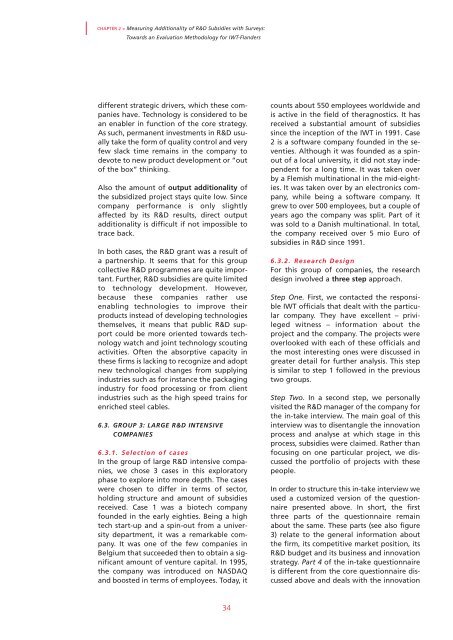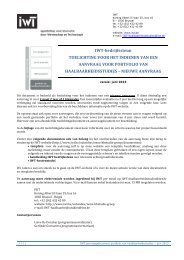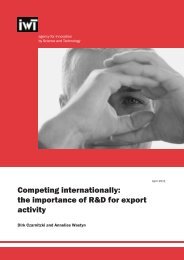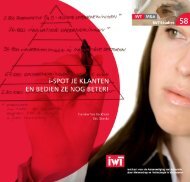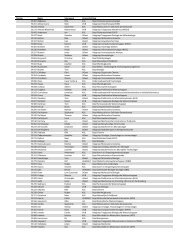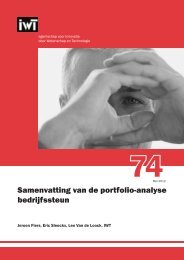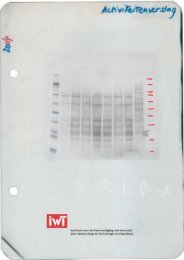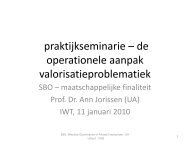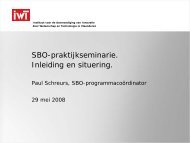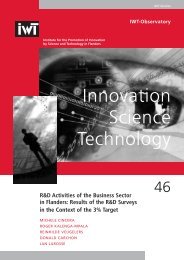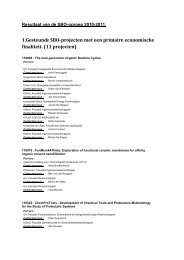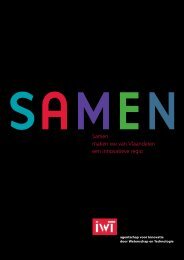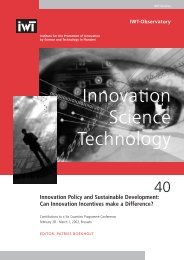The Evaluation of 'Behavioural Additionality' - IWT
The Evaluation of 'Behavioural Additionality' - IWT
The Evaluation of 'Behavioural Additionality' - IWT
You also want an ePaper? Increase the reach of your titles
YUMPU automatically turns print PDFs into web optimized ePapers that Google loves.
CHAPTER 2 > Measuring Additionality <strong>of</strong> R&D Subsidies with Surveys:<br />
Towards an <strong>Evaluation</strong> Methodology for <strong>IWT</strong>-Flanders<br />
different strategic drivers, which these companies<br />
have. Technology is considered to be<br />
an enabler in function <strong>of</strong> the core strategy.<br />
As such, permanent investments in R&D usually<br />
take the form <strong>of</strong> quality control and very<br />
few slack time remains in the company to<br />
devote to new product development or “out<br />
<strong>of</strong> the box” thinking.<br />
Also the amount <strong>of</strong> output additionality <strong>of</strong><br />
the subsidized project stays quite low. Since<br />
company performance is only slightly<br />
affected by its R&D results, direct output<br />
additionality is difficult if not impossible to<br />
trace back.<br />
In both cases, the R&D grant was a result <strong>of</strong><br />
a partnership. It seems that for this group<br />
collective R&D programmes are quite important.<br />
Further, R&D subsidies are quite limited<br />
to technology development. However,<br />
because these companies rather use<br />
enabling technologies to improve their<br />
products instead <strong>of</strong> developing technologies<br />
themselves, it means that public R&D support<br />
could be more oriented towards technology<br />
watch and joint technology scouting<br />
activities. Often the absorptive capacity in<br />
these firms is lacking to recognize and adopt<br />
new technological changes from supplying<br />
industries such as for instance the packaging<br />
industry for food processing or from client<br />
industries such as the high speed trains for<br />
enriched steel cables.<br />
6.3. GROUP 3: LARGE R&D INTENSIVE<br />
COMPANIES<br />
6.3.1. Selection <strong>of</strong> cases<br />
In the group <strong>of</strong> large R&D intensive companies,<br />
we chose 3 cases in this exploratory<br />
phase to explore into more depth. <strong>The</strong> cases<br />
were chosen to differ in terms <strong>of</strong> sector,<br />
holding structure and amount <strong>of</strong> subsidies<br />
received. Case 1 was a biotech company<br />
founded in the early eighties. Being a high<br />
tech start-up and a spin-out from a university<br />
department, it was a remarkable company.<br />
It was one <strong>of</strong> the few companies in<br />
Belgium that succeeded then to obtain a significant<br />
amount <strong>of</strong> venture capital. In 1995,<br />
the company was introduced on NASDAQ<br />
and boosted in terms <strong>of</strong> employees. Today, it<br />
counts about 550 employees worldwide and<br />
is active in the field <strong>of</strong> theragnostics. It has<br />
received a substantial amount <strong>of</strong> subsidies<br />
since the inception <strong>of</strong> the <strong>IWT</strong> in 1991. Case<br />
2 is a s<strong>of</strong>tware company founded in the seventies.<br />
Although it was founded as a spinout<br />
<strong>of</strong> a local university, it did not stay independent<br />
for a long time. It was taken over<br />
by a Flemish multinational in the mid-eighties.<br />
It was taken over by an electronics company,<br />
while being a s<strong>of</strong>tware company. It<br />
grew to over 500 employees, but a couple <strong>of</strong><br />
years ago the company was split. Part <strong>of</strong> it<br />
was sold to a Danish multinational. In total,<br />
the company received over 5 mio Euro <strong>of</strong><br />
subsidies in R&D since 1991.<br />
6.3.2. Research Design<br />
For this group <strong>of</strong> companies, the research<br />
design involved a three step approach.<br />
Step One. First, we contacted the responsible<br />
<strong>IWT</strong> <strong>of</strong>ficials that dealt with the particular<br />
company. <strong>The</strong>y have excellent – privileged<br />
witness – information about the<br />
project and the company. <strong>The</strong> projects were<br />
overlooked with each <strong>of</strong> these <strong>of</strong>ficials and<br />
the most interesting ones were discussed in<br />
greater detail for further analysis. This step<br />
is similar to step 1 followed in the previous<br />
two groups.<br />
Step Two. In a second step, we personally<br />
visited the R&D manager <strong>of</strong> the company for<br />
the in-take interview. <strong>The</strong> main goal <strong>of</strong> this<br />
interview was to disentangle the innovation<br />
process and analyse at which stage in this<br />
process, subsidies were claimed. Rather than<br />
focusing on one particular project, we discussed<br />
the portfolio <strong>of</strong> projects with these<br />
people.<br />
In order to structure this in-take interview we<br />
used a customized version <strong>of</strong> the questionnaire<br />
presented above. In short, the first<br />
three parts <strong>of</strong> the questionnaire remain<br />
about the same. <strong>The</strong>se parts (see also figure<br />
3) relate to the general information about<br />
the firm, its competitive market position, its<br />
R&D budget and its business and innovation<br />
strategy. Part 4 <strong>of</strong> the in-take questionnaire<br />
is different from the core questionnaire discussed<br />
above and deals with the innovation<br />
34


